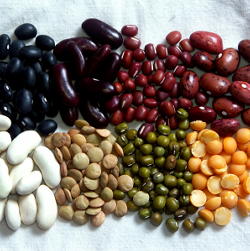Save and Store your seed

Seed saving is fun, thrifty and sociable (swap with other gardeners and maybe discover some varieties you haven’t tried before).
Many hardy annuals, (that’s the ones that survive the frost) such as Calendulas, (pot marigold), Eschsholzia californica, (Californian poppy), Nigella damascene, (love in a mist) and Tropaeolum majus (nasturtiums), produce massive amounts of seeds that can be stored and used again next year, or, if you have lots of it, swapped at the seed swap in February see www.seedysunday.org . If you time the seed collection right, then nature will have dried the seed for you. Dry seed falls quickly to the ground – blink and you will miss it! With something like Papaver somniferum (the opium poppy), you can pick the whole head and hang it upside down and eventually the ‘pepper pot’ will open over a number days to release the seed.
It is better to collect all your seed in paper bags and then the seeds can continue to dry out. Clean your seeds to separate them from the chaff. Store them in plastic tubs like the ones from Chinese takeaway or the ones you get with hummus etc in.
If you have melons or pumpkins these may be wet and the best way to remove the seed from the flesh is with the back of a spoon rub the seed into a sieve under running water. Once you have removed as much flesh as possible leave them to dry on kitchen towel and then store them, preferably in a fridge at 1-5º.
If you want to save the seed of berries such as Cotoneaster, Pyracantha, or Viburnum opulus, all of which are brilliant hedging plants and also very good for wildlife, put them into a fine sieve and squash them under running water until they are well mashed. Then put all the fruit pulp into a jar of water and let it settle, the viable seed will sink and the flesh will float and then you can separate them and dry them on kitchen towel and store them.
Try to collect things like foxgloves and aquilegia on a dry day and then just shake them onto a piece of paper. Remember that lettuce are in the same family,( Asteraceae), as dandelions and the thistle forming seed heads of the lettuce can be cleaned by rubbing them through a fine sieve with a piece of paper underneath to catch the seeds.
If you want to collect your tomato seeds you will discover that they are covered in a gelatinous substance which is there to stop the seed from germinating in the tomato. Scoop out the seed of the tomato and wash them in a sieve. If you put the seeds in a glass of water and add some washing up liquid and leave them overnight you will find that the viable seeds will sink to the bottom, but the immature seeds will float to the top. You can then skim off the immature seeds and strain off the good seeds and dry them on coffee filter paper or a plate – if you use kitchen towel the seeds will stick and be difficult to remove.
Some seeds, such as acorns and walnuts tend to be oily and if they are allowed to dry out they won’t germinate as they won’t be able to take up water. The best way to store these is in some vermiculite in a sealed polythene bag in the fridge.
Some of your seeds of things like pumpkins will have cross pollinated or hybridised. This happens when the male pollen from one flower is taken to the female stigma of a different flower. The insects won’t care what plant it is – all they care about is reproducing! If you leave your yellow courgettes alone they won’t necessarily produce yellow courgettes, you will need to isolate your plants and stop them from being visited by pollinators by covering their head with a paper bag. This is the way that hellebores are grown as they are very promiscuous and end up hybridising with each other to produce rather dull cultivars!
There is no problem in collecting hybridized seed – it makes for allsorts of interesting varieties, it is just worth remembering that you will need to isolate the flower from any unwanted visitors if you want to get exactly the same plant again.
However when saving seed, steer clear of F1 hybrids, as the plants you grow from the seeds of an F1 will not remain true, and are likely to be weaker, and with lower yields.
Follow these simple tips to collect seed of your favourite plants and store them until you are ready to use them:
- Allow flowers to go to seed
- Choose the best/healthiest plants to collect seed from
- Collect the seed heads or seed pods on a warm sunny day in separate paper bags
- The drier the seeds the better, so if in doubt, place and spread out the seed heads on large sheets of newspaper, so that seeds are collected when they fall, in warm dry conditions until completely dry
- Put the seeds in envelopes and label them with the variety name and date
- Place the envelopes in airtight containers with sachets of silica gel
- Put the container in a cool, dry place in a fridge, but not a freezer
SHELF LIFE
| 1-2 years | 3-4 years | 5+ years |
| beetroot | carrots | brussels sprouts |
| leeks | broad beans | cabbages |
| onions | french beans | cauliflowers |
| parsley | runner beans | cucumbers |
| spinach | marrows | endives |
| sweetcorn | courgettes | kale |
| sweet peppers | peas | lettuce |
| chili peppers | pumpkins | radishes |
| tomatoes | ||
| turnips |





No Comments
Add a comment about this page